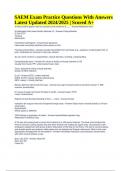A false positive guaiac may be caused by the presence of ___ - Answer-Methylene blue GI pathogens that cause bloody diarrhea (4) - Answer-Campylobacter E Coli O157 Yersinia Salmonella Clostridium perfringens - Answer-Gas gangrene Late onset non-bloody diarrhea (from spores in dirt) Yersinia enterocolitica - Answer-Usually transmitted from pet feces (e.g., puppies), contaminated milk, or pork. Outbreaks are common in day-care centers. Sx can mimic Crohn's or appendicitis - bloody diarrhea, vomiting, cramping RLQ Campylobacter jejuni - Answer-#1 cause of watery or bloody diarrhea in US Usually from travel, PPI, undercooked meat, dairy Fever, abdominal cramp, bloody diarrhea Similar to EIEC infection E coli - Answer-ETEC: watery diarrhea EHEC (O157): bloody diarrhea without fever EIEC: watery > bloody diarrhea Bloody diarrhea with thumb-print sign - Answer-Any sign of bowel ischemia (ischemic bowel >> IBD, volvulus, diverticulitis) #1 cause of upper and lower GI bleed in adults - Answer-Upper: PUD Lower: diverticulosis Majority of diverticulosis bleeding is from __ colon - Answer-R side Indication for surgical removal of ingested foreign body - Answer-Object hasn't moved distally in 24 hour observation Symptomatic Sharp object or batteries CXR findings in aspiration of object - Answer-Hyperinflated opposite lung Atelectasis of affected lung A 22 year old running back is struck from behind by a 300-pound lineman. The blow occurs below the knee as his foot is firmly planted and two other lineman are holding his upper body. He presents to the emergency department with gross anterior dislocation of the tibia on the femur. His foot is cool and palee, and dorsalis pedis and posterior tibial pulses are not detected by Doppler ultrasound. What is the most appropriate management for this patient? - Answer-Immediate reduction (neurovascular compromise) with ortho consult without x-rays Burn rule of 9s - Answer-Head 9% Each arm 9% Chest 9% SAEM Exam Practice Questions With Answers Latest Updated 2024/2025 | Scored A+ Abdomen 9% Each anterior leg 9% Each posterior leg 9% Upper back 9% Lower back 9% Genitals 1% Treatment compartment syndrome - Answer-Emergency escharotomy Human bite microbes - Answer-Eikenella corrodens Expanding intracranial epidural hemorrhage management - Answer-Intubate and consult neurosurgery to take the patient to the OR Depression and IBD - Answer-IBD = higher rate of depression and anxiety A 42 year old male with end stage liver disease due to chronic hepatitis C infection arrives to the emergency department in stable condition after an unsuccessful suicide attempt by bilateral wrist laceration. He reports no history of depression or psychiatric disorder. Aside from his liver disease, for which he takes interferon alpha and ribavirin, he reports that he is in good health and takes no other medications. Which of the following factors increased this patient's risk of new-onset suicidal ideation? - Answer-Depression and/ or suicidal ideation are commonly reported side effects of interferon alpha therapy Which of the following psychiatric disorders is associated with the greatest increased risk of committing suicide? Panic PTSD Schizophrenia Depression - Answer-Panic disorder Silent suicide - Answer-slowly killing oneself by nonviolent means; starvation/noncompliance with essential tx Populations with increased suicide risk - Answer-Old caucasian people Young native american or alaskan natives PUD vs gastritis - Answer-PUD: unrelenting pain for weeks, not better with antacids Liver abscess management - Answer--drainage (not necessarily immediate in ED) -IV antibiotics -look for R effusion and elevation of hemidiaphragm on CXR Proparacaine is a ____ anesthetic (type) - Answer-ester Optic neuritis treatment - Answer-IV steroids (not oral) Nonspecific signs in both preseptal and orbital cellulitis - Answer-Fever Leukocytosis (only orbital has EOM pain or VA impairment) Horner's syndrome symptoms - Answer-Ptosis, miosis, anhydrosis Hyperemia of skin Pseudo-enophthalmos (from lid) NO ophthalmoplegia Delirium definition - Answer-A global inability to relate to the environment and process sensory input Criteria that is NOT enough for inpatient psych admission - Answer-First episode (counts: lack of support, no medication, harm) Which one is least likely associated with organic confusion? DM Hypothyroid Alcoholism COPD - Answer-Hypothyroidism - usually causes depression, very rarely causes myxedema crisis Hypothermia temp + symptoms (mild, moderate, severe) - Answer-Mild (32-35): tachycardia, shivering Moderate (28-32): bradycardia, AMS Severe (<28): vfib, unconscious Lightning strike sequelae - Answer-CV (systole, arrhythmia) Resp arrest Neuro Vascular coagulation GI, ENT BURNS ARE RARE !!!!! Treatment of severe hypothermia - Answer-Severe = <28 C Warm IV fluids Warm humidified air, blankets, BAIR hugger Arrhythmias usually treated AFTER rewarming Scorpion sting management - Answer-Local: local wound care, tetanus prophylaxis, opioids for muscle pain, and benzodiazepines Central (somatic and neuro): antivenom Scorpion sting presentation - Answer-DOES NOT HAVE PUNCTURE WOUND OR LOCAL ERYTHEMA!!!! Severe sensitivity to touch at the site (tap sign), numbness, tingling, anxiety, nausea/vomiting, blurred vision Envenomation: hypersalivation, abnormal roving eye movements, fasciculations, and clonus Cholinergic syndrome: hyperthermia, hypertension, tachycardia and excessive respiratory secretions Viper bite presentation - Answer-Local: bite site edematous and tense, ecchymosis, fluid filled or hemorrhagic bullae, tissue destruction may eventually develop. Systemic: hematologic abnormalities, oral paresthesias, metallic taste, fasciculations, tachycardia, hypotension and anaphylaxis Elapdae bite presentation - Answer-AKA coral snake (red and yellow kill a fellow)




